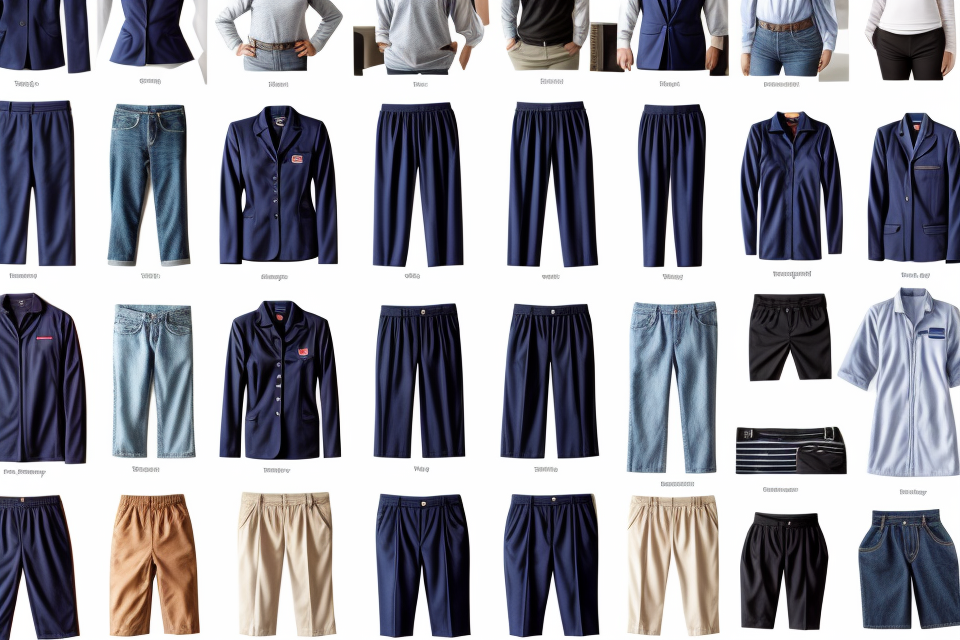
Measuring for a dress uniform is an essential task that requires precision and accuracy. Whether you are a member of the military, police force, or any other organization that requires a dress uniform, getting the right measurements is crucial to ensure a perfect fit. In this comprehensive guide, we will discuss the steps involved in measuring for a dress uniform, including the tools and techniques needed to ensure accurate measurements. With this guide, you will be able to measure yourself or others for a dress uniform with confidence, and achieve the perfect fit every time. So, let’s get started!
Understanding Dress Uniforms
What is a dress uniform?
A dress uniform is a type of formal attire worn by individuals in certain professions, such as military personnel, police officers, and members of various organizations. It is typically characterized by a distinctive style and color scheme, and is worn on special occasions or for official events. Examples of dress uniforms include the Navy’s formal blue uniform, the Army’s Service Dress Coat, and the Air Force’s Mess Dress. These uniforms often include a jacket, trousers, shirt, tie, and other accessories, and are designed to project a professional and polished image.
Importance of a proper fit
A dress uniform is an essential part of one’s attire, particularly in formal settings. It is crucial to ensure that the dress uniform fits perfectly to make a good impression. A proper fit not only enhances one’s appearance but also contributes to confidence and comfort during wear.
On the other hand, a poorly fitting dress uniform can have negative consequences. It can create an unflattering appearance, affect posture, and cause discomfort, which can lead to distractions and even affect one’s performance. Therefore, it is crucial to understand the importance of a proper fit when it comes to dress uniforms.
Measuring Your Body
Taking accurate measurements
Accurate measurements are crucial when it comes to getting the right fit for your dress uniform. To ensure that you get the right measurements, follow these steps:
- Choose the right measuring tape: The measuring tape should be of high quality and have a flexible, retractable tape that can easily wrap around your body.
- Measure in comfortable clothing: Wear light clothing that is comfortable and not too tight or too loose. This will ensure that the measurements are accurate and not affected by the type of clothing you are wearing.
- Measure in a quiet, well-lit room: Avoid measuring in a room with too much noise or bright lights, as this can affect the accuracy of the measurements.
- Take multiple measurements: Take multiple measurements in different parts of your body to ensure that you get an accurate reading. For example, take three measurements in the chest area and record the largest measurement.
- Avoid common mistakes: Some common mistakes to avoid when taking measurements include:
- Not using a high-quality measuring tape: A low-quality measuring tape can lead to inaccurate measurements.
- Measuring too quickly or too slowly: Measuring too quickly can lead to inconsistent measurements, while measuring too slowly can cause the tape to stretch or become inaccurate.
- Measuring in awkward positions: Measuring in an awkward position can lead to inaccurate measurements.
- Rounding off measurements: Rounding off measurements can also lead to inaccurate results.
By following these steps, you can ensure that you take accurate measurements and get the right fit for your dress uniform.
Measuring key body parts
When measuring for a dress uniform, it is important to take accurate measurements of key body parts to ensure a proper fit. Here are the steps to follow:
- Measure the chest: To measure the chest, place the tape measure just under the arms and around the fullest part of the chest. Make sure the tape measure is level and straight. Take the measurement and add a few inches for comfort.
- Measure the waist: To measure the waist, place the tape measure around the natural waistline, just above the belly button. Make sure the tape measure is level and straight. Take the measurement and add a few inches for comfort.
- Measure the sleeve length: To measure the sleeve length, place the tape measure from the center of the back of the neck, down the shoulder, and along the outside of the arm to the wrist. Make sure the tape measure is level and straight. Take the measurement and add a few inches for comfort.
- Measure the inseam: To measure the inseam, place the tape measure from the top of the inner thigh, down the leg to the ankle. Make sure the tape measure is level and straight. Take the measurement and add a few inches for comfort.
- Measure the length of the dress uniform: To measure the length of the dress uniform, place the tape measure from the top of the shoulder, down the front of the chest, and along the hem of the dress to the length desired. Make sure the tape measure is level and straight. Take the measurement and add a few inches for comfort.
By following these steps, you can ensure that your dress uniform fits you perfectly and makes you look and feel your best.
Selecting the Right Size
Choosing the right size based on measurements
When it comes to choosing the right size for your dress uniform, it’s important to rely on measurements rather than guesswork. This is because the sizing of dress uniforms can vary greatly between different manufacturers and styles, and even within the same brand, different styles may fit differently. By taking accurate measurements, you can ensure that your dress uniform fits you perfectly and looks professional.
Here are some tips for choosing the right size based on measurements:
- Understanding sizing charts: Before taking any measurements, it’s important to understand the sizing charts provided by the manufacturer. These charts will give you an idea of what measurements are required for each size, as well as any variations in sizing between different styles.
- Taking accurate measurements: To ensure that you get an accurate reading of your measurements, it’s important to use a flexible tape measure. Wrap the tape measure around the appropriate area of your body, making sure to keep it level and straight. Take your measurements in inches, and write them down in a table for easy reference.
- Factors to consider when choosing the right size: In addition to the measurements, there are other factors to consider when choosing the right size for your dress uniform. These include your body shape, activity level, and personal preferences. For example, if you have a larger chest, you may need to go up a size in the chest area to ensure a comfortable fit.
Overall, choosing the right size based on measurements is crucial to getting a perfect fit for your dress uniform. By understanding sizing charts, taking accurate measurements, and considering other factors, you can ensure that your dress uniform looks professional and fits you perfectly.
Alterations and adjustments
When it comes to dress uniforms, it’s important to ensure that the fit is just right. Sometimes, despite your best efforts, the uniform may not fit perfectly out of the box. In these cases, alterations and adjustments may be necessary. Here’s what you need to know:
When alterations are necessary
If the dress uniform doesn’t fit properly, alterations may be necessary. Common issues include sleeves that are too long or too short, a hem that’s too long or too short, or a waist that’s too loose or too tight. Additionally, if the uniform is made of a material that doesn’t breathe well, alterations may be necessary to ensure comfort.
Types of alterations and adjustments
There are several types of alterations and adjustments that can be made to a dress uniform. These include:
- Hemming: If the hem is too long or too short, a professional seamstress can hem the uniform to the appropriate length.
- Taking in or letting out: If the waist is too loose or too tight, a seamstress can take in or let out the seams to achieve the desired fit.
- Shortening or lengthening sleeves: If the sleeves are too long or too short, a seamstress can shorten or lengthen the sleeves as needed.
- Altering the shoulders: If the shoulders don’t fit properly, a seamstress can alter the shape of the shoulders to ensure a better fit.
- Removing or adding darts: Darts are often used to shape the dress uniform, but if they don’t fit properly, they can be removed or added as needed.
It’s important to work with a professional seamstress when making alterations to a dress uniform. They will have the experience and expertise necessary to ensure that the alterations are made correctly and won’t damage the uniform. Additionally, they can advise on the best course of action for any alterations needed, based on the type of material and construction of the uniform.
Choosing the right type of dress uniform
When it comes to selecting the right type of dress uniform, there are several factors to consider. The first step is to understand the different types of dress uniforms available. Here are some of the most common types:
- Business formal dress uniforms: These are typically worn by professionals in industries such as finance, law, and real estate. They often include a suit, dress shirt, tie, and dress shoes.
- Military dress uniforms: These are worn by members of the armed forces and often include a dress coat, trousers, and a dress hat.
- Ceremonial dress uniforms: These are worn for special occasions such as weddings, graduations, and formal dinners. They often include a tuxedo or formal gown.
- School dress uniforms: These are worn by students in private and some public schools. They often include a blazer, dress shirt, tie, and dress pants or skirt.
Once you have identified the type of dress uniform you need, the next step is to consider the factors that will influence your choice. Here are some key factors to keep in mind:
- Occasion: The occasion for which you will be wearing the dress uniform will impact your choice. For example, a business formal dress uniform may be more appropriate for a job interview or a board meeting, while a military dress uniform may be more appropriate for a formal military event.
- Climate: The climate in which you will be wearing the dress uniform will also impact your choice. For example, a suit and tie may be more appropriate for a winter wedding, while a summer wedding may call for a lightweight suit or even a linen suit.
- Personal style: Your personal style will also play a role in your choice of dress uniform. If you prefer a more traditional look, a military or ceremonial dress uniform may be more appropriate. If you prefer a more modern look, a business formal dress uniform may be more appropriate.
- Budget: Finally, your budget will also play a role in your choice of dress uniform. Some types of dress uniforms can be quite expensive, so it’s important to consider your budget when making your selection.
Putting it All Together
Assembling the dress uniform
Once you have accurately measured all the necessary parts for your dress uniform, it’s time to assemble it. Here are the steps to follow:
- Start by putting on the dress shirt. Make sure it fits well and is tucked into your trousers.
- Next, put on the tie. The knot should sit at the appropriate height, typically at the belly button.
- Put on the jacket, making sure the sleeves are rolled down to the wrists.
- Fasten the buttons on the jacket, starting from the bottom up.
- Put on the trousers, making sure they fit well and are not too loose or too tight.
- Add any accessories such as epaulets, rank insignia, or name tags.
- Finally, put on your shoes, making sure they are polished and in good condition.
It’s important to note that the assembly of the dress uniform should be done with attention to detail, ensuring that each piece is in its proper place and everything looks neat and tidy. The final result should be a well-put-together uniform that looks professional and respectable.
Common mistakes to avoid
When assembling a dress uniform, it is important to avoid common mistakes that can detract from the overall appearance and fit of the uniform. Here are some of the most common mistakes to watch out for:
- Incorrect sizing: One of the most common mistakes is choosing a uniform that is too small or too large. This can cause the uniform to look ill-fitting and unprofessional. To avoid this mistake, it is important to take accurate measurements and choose a uniform that fits perfectly.
- Wrong choice of fabric: Another mistake is choosing the wrong type of fabric for the uniform. For example, if the uniform requires a specific type of fabric, such as a specific weight or finish, choosing the wrong fabric can result in a uniform that looks and feels cheap or unprofessional.
- Inconsistent sizing: When assembling the uniform, it is important to ensure that all the pieces fit correctly. For example, if the jacket is too small, it may not fit over the shirt properly, which can look unprofessional. To avoid this mistake, it is important to measure each piece separately and ensure that they all fit together correctly.
- Improper alterations: Alterations are often necessary to ensure a perfect fit, but improper alterations can have the opposite effect. For example, if the trousers are too long, they may get caught on the shoes, which can look unprofessional. To avoid this mistake, it is important to work with a professional alterations service to ensure that all alterations are done correctly.
By avoiding these common mistakes, you can ensure that your dress uniform looks professional, well-fitted, and stylish.
Caring for the dress uniform
Proper care and maintenance of the dress uniform is essential to ensure that it looks its best and lasts for a long time. Here are some tips on how to care for your dress uniform:
- Clean the dress uniform regularly: The dress uniform should be cleaned regularly to remove any dirt, stains, or wrinkles. It is recommended to use a mild detergent and cool water when washing the dress uniform.
- Press the dress uniform: The dress uniform should be pressed to remove any wrinkles and creases. This can be done using a steam iron or a professional dry cleaner.
- Store the dress uniform properly: The dress uniform should be stored in a cool, dry place, away from direct sunlight and moisture. It is recommended to store the dress uniform in a hanging garment bag or a box.
- Inspect the dress uniform regularly: It is important to inspect the dress uniform regularly for any signs of wear and tear, such as loose buttons or frayed edges. Any issues should be addressed promptly to prevent further damage.
By following these tips, you can ensure that your dress uniform looks its best and lasts for a long time.
FAQs
1. What is a dress uniform?
A dress uniform is a type of uniform that is typically worn for formal or ceremonial occasions. It is often used by military personnel, law enforcement officers, and other public servants.
2. Why is it important to measure for a dress uniform?
Measuring for a dress uniform is important because it ensures that the uniform fits properly and looks professional. A well-fitting dress uniform can enhance one’s appearance and boost confidence, while a poorly fitting uniform can detract from one’s appearance and create a negative impression.
3. What are the steps involved in measuring for a dress uniform?
The steps involved in measuring for a dress uniform typically include taking measurements of the individual’s body, selecting the appropriate size and style of the uniform, and ensuring that the uniform is altered to fit properly. The specific steps involved may vary depending on the type of uniform and the individual’s body measurements.
4. How do I take accurate body measurements for a dress uniform?
To take accurate body measurements for a dress uniform, it is important to use a measuring tape and follow the instructions carefully. Measurements should be taken while the individual is standing and wearing light clothing. It is also important to ensure that the measurements are taken accurately and consistently to ensure that the uniform fits properly.
5. What are the different components of a dress uniform that need to be measured?
The different components of a dress uniform that need to be measured typically include the jacket, trousers, shirt, and tie. The measurements may include the chest, waist, inseam, and length of the sleeves and pants. The specific measurements required may vary depending on the type of uniform and the individual’s body measurements.
6. How do I select the appropriate size and style of a dress uniform?
Selecting the appropriate size and style of a dress uniform typically involves considering the individual’s body measurements, the occasion for which the uniform will be worn, and any specific requirements or regulations associated with the uniform. It is important to consult with a professional or refer to the manufacturer’s size chart to ensure that the correct size and style are selected.
7. How is a dress uniform altered to fit properly?
A dress uniform is typically altered to fit properly by a professional tailor or seamstress. The alterations may include adjusting the sleeve length, waist size, and inseam length, as well as making any other necessary adjustments to ensure a proper fit. It is important to have the uniform altered by a professional to ensure that it looks professional and fits properly.
8. How do I care for a dress uniform?
Caring for a dress uniform typically involves following the manufacturer’s instructions for cleaning and maintenance. It is important to avoid using harsh chemicals or bleach when cleaning the uniform, as this can damage the fabric and alter the appearance of the uniform. It is also important to store the uniform properly to prevent wrinkles and damage.


